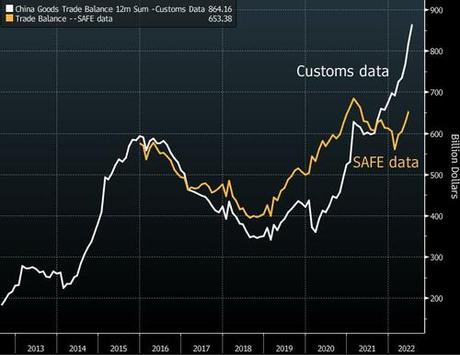An unusual discrepancy has showed up in two sets of trade data in China. Depending on which official sources you use, China's trade surplus, could either be overstated or under-reported by a staggering $166 billion over the past year.
China watchers cannot fully explain the mystery. It's as if Chinese residents bought a lot of stuff overseas, and instead of shipping the items home, they were kept abroad for some reason.
China's exports have been surprisingly resilient, despite a slowing global economy and Covid disruptions. On Monday, General Administration of Customs data showed China's exports increased 18% in July from a year earlier. In contrast, imports grew only 2.3%, reflecting weak domestic demand.
The result is China's trade surplus keeps swelling, which has underpinned the yuan by offsetting capital outflows. The surplus over the past year amounted to a record $864 billion, more than double the level at the end of 2019.
But when comparing the Customs data with that from the State Administration of Foreign Exchange (SAFE), a different picture emerges. The SAFE data shows the surplus is growing at a much slower pace - about 20% less than the customs figure.

The two data sets used to track each other closely. SAFE typically reports fewer imports, thus a higher surplus, because it excludes costs, insurance and freight from the value of goods imported, in line with the international standard practice, Adam Wolfe, an economist at Absolute Strategy Research, noted.
The other adjustments that SAFE does include:
- It only records transactions that involve a change of ownership;
- It adjusts for returned items;
- It adds goods bought and resold abroad that don't cross China's border, but result in income for a Chinese entity - a practice known as "merchanting."
The relationship between the two data sets has flipped since 2021, as SAFE reported higher imports, resulting in a smaller surplus than the Customs data.
It's particularly odd because it happened at a time when shipping costs skyrocketed. When SAFE removes freight and insurance costs, it would have resulted in even lower, not higher, imports.
Taken at face value, the discrepancy suggests that somebody in China "bought" lots of goods from abroad, but they have never arrived in China. These transactions would be recorded by SAFE as imports, but not at the Customs office.Craig Botham at Pantheon Macroeconomics, suspects that Covid-19 may be playing a role here. Foreign firms unable to manufacture in factories elsewhere during the pandemic might have transferred materials to China for assembly, a transaction excluded by SAFE.
Could Chinese buyers overstate their foreign purchases to SAFE, which regulates the capital account, so they can move money out of the country? The cross-border transactions show there was widespread overpaying for imports in 2014-2015, during a period of intense capital flight, but not at the moment, Wolfe pointed out.
The bottom line is that there aren't many good explanations. As Alex Etra, a senior strategist at Exante Data, said, there's "no smoking gun" to suggest something fishy is going on.
It's another mysterious puzzle waiting to be solved.

